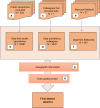DataTri, a database of American triatomine species occurrence
- PMID: 29688221
- PMCID: PMC5914284
- DOI: 10.1038/sdata.2018.71
DataTri, a database of American triatomine species occurrence
Abstract
Trypanosoma cruzi, the causative agent of Chagas disease, is transmitted to mammals - including humans - by insect vectors of the subfamily Triatominae. We present the results of a compilation of triatomine occurrence and complementary ecological data that represents the most complete, integrated and updated database (DataTri) available on triatomine species at a continental scale. This database was assembled by collecting the records of triatomine species published from 1904 to 2017, spanning all American countries with triatomine presence. A total of 21815 georeferenced records were obtained from published literature, personal fieldwork and data provided by colleagues. The data compiled includes 24 American countries, 14 genera and 135 species. From a taxonomic perspective, 67.33% of the records correspond to the genus Triatoma, 20.81% to Panstrongylus, 9.01% to Rhodnius and the remaining 2.85% are distributed among the other 11 triatomine genera. We encourage using DataTri information in various areas, especially to improve knowledge of the geographical distribution of triatomine species and its variations in time.
Conflict of interest statement
The authors declare no competing interests.
Figures




References
Data Citations
-
- Ceccarelli S., et al. . 2018. figshare. https://dx.doi.org/10.6084/m9.figshare.c.3946936 - DOI
References
-
- WHO. Investing to overcome the global impact of neglected tropical diseases. Third WHO report on neglected tropical diseases. WHO/HTM/NTD/2015.1 (World Health Organization, 2015).
-
- Carcavallo R. U. et al. in Atlas of Chagas´ Disease Vectors in the Americas (eds Carcavallo R. U., Galíndez Girón I., Jurberg J., Lent H.) 747–792 (Fio Cruz, 1998).
-
- Galvão C. & Justi S. A. An overview on the ecology of Triatominae (Hemiptera: Reduviidae). Acta Trop. 151, 116–125 (2015). - PubMed
-
- Galvão C. Vetores da Doença de Chagas no Brasil (Sociedade Brasileira de Zoologia, 2014).
Publication types
MeSH terms
Associated data
LinkOut - more resources
Full Text Sources
Other Literature Sources
Molecular Biology Databases

